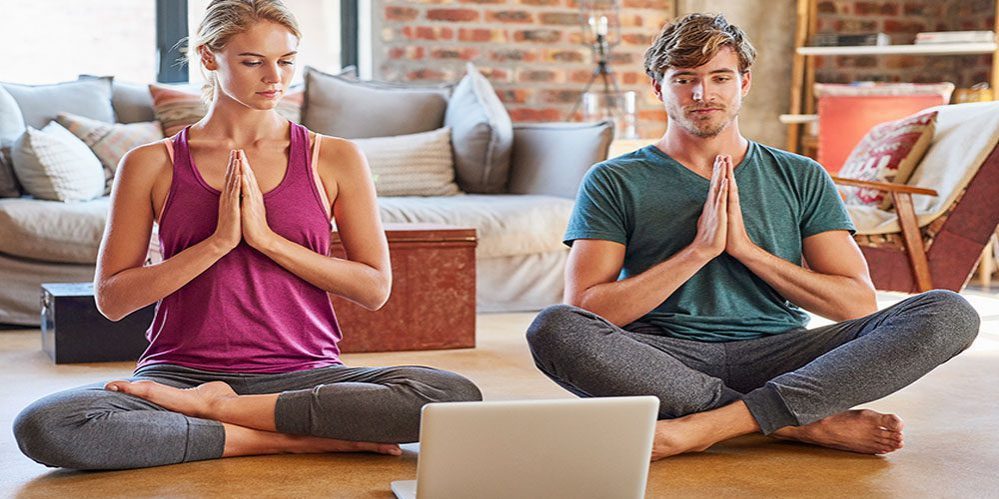Imagine a serene morning; the sun is just beginning to rise, casting a gentle glow over the horizon. The air is crisp, fresh, and filled with a sense of tranquility and peace.
It is in such moments that one finds the perfect setting for diving deep into the world of meditative yoga – an ancient practice dedicated to unifying the mind and body in harmony through purposeful movement and mindful meditation. Embracing its wisdom allows us to cultivate inner peace, foster physical health, and achieve a heightened state of awareness.
Meditative yoga is not just about flexibility or mastering sophisticated poses; it’s about cultivating mindfulness and bringing stillness to our turbulent minds. As we traverse through this enlightening journey together, we’ll explore its roots, understand its significance from both historical and modern perspectives, delve into its profound mind-body connection effects, and provide you with valuable insights on how to incorporate this spiritual discipline into your lifestyle.
Brief History: From Ancient Roots to Modern Mats – Unfolding Millennia of Wisdom
Our journey began thousands of years ago when yogis (practitioners of yoga) retreated deep into Indian forests practicing asceticism in their quest for enlightenment. They developed postures (asanas), breathing techniques (pranayama), ethical principles (yamas and niyamas), and meditation practices (dhyana) – all integral elements of meditative yoga today. Fast-forward several centuries later yoga made its appearance in sacred texts called Upanishads around 500 BCE.
These texts elaborated on Brahmanical rituals that involved stretching exercises used as preparation for long periods of meditation; this primitive form was notably different yet held the embryonic roots of what would eventually unfold as meditative yoga. The discipline traveled across seas in the late 19th century when Swami Vivekananda, a revered Indian yogi, introduced yoga to the Western world.
However, it wasn’t until the mid-20th century that yoga started gaining widespread popularity in Western societies. Guided by renowned teachers such as B.K.S. Iyengar and Pattabhi Jois, yoga evolved from an esoteric practice into a global wellness phenomenon.
But the journey didn’t stop there; by the 21st century, yoga had expanded into various derivative forms including what we now know as meditative yoga – a beautiful blend of physical postures with mindfulness meditation.
The Mind-Body Connection: Why Meditative Yoga?
Human beings are complex creatures woven from biological, psychological, and spiritual threads. Often in our fast-paced lives, these elements move out of sync leading to stress and disorientation.
This is where meditative yoga steps in – it presents an opportunity to restore that balance between our mental and physical selves. The practice of meditative yoga offers us a chance to engage with our bodies mindfully. Through each pose or ‘asana’, we bring awareness not just to our physical forms but also to our breath and thoughts creating holistic synchronicity – a rare commodity in today’s bustling world.
Meditative Yoga goes beyond mere exercise; it’s about establishing a dialogue between your mind and body where each pose becomes an expression of quiet introspection. It teaches you how to listen keenly for cues from your body while maintaining stillness in your mind despite the surrounding chaos.
Scientific research backs up these claims showing that regular practice of meditative yoga can have profound effects on mental health reducing stress levels, and anxiety symptoms and even improving sleep quality. Further studies have shown its positive impact on physical well-being enhancing flexibility, boosting immunity, and improving cardiovascular health among others. All things considered; whether you’re seeking physical vitality or yearning for emotional tranquility, meditative yoga presents a holistic avenue to wellness, making it an invaluable addition to modern lifestyles. Let’s embark together on this enlightening journey into the heart of meditative yoga.
Unraveling the Mystery of Meditation – A Beginner’s Guide to Inner Peace
Meditation, at its most fundamental level, is a mental exercise that involves relaxation, focus, and awareness. It has been compared to fitness training for our minds. While exercises strengthen our muscles, meditative practices bring about mental fitness.
Meditation is all about bringing your attention inward and giving your busy mind a well-deserved break from the constant barrage of thoughts. During meditation, the practitioner concentrates on a specific object, thought, visualization or activity while eliminating the stream of jumbled thoughts crowding their mind.
You see, our minds are incessantly chattering in a ceaseless internal dialogue that can often be stressful. By focusing our attention and eliminating the stream of thoughts overwhelming us daily, we can experience true tranquility.
It’s like turning down the volume knob on life’s noise pollution for a moment – no deadlines to chase or errands to run; just you being entirely present without judgment or anticipation. So let’s simplify it even more: meditation is an ancient practice that involves calming your mind and body by focusing your attention away from everything you’re doing right now.
Different Styles of Meditation: A Symphony of Silence
While meditation may seem homogenous to those unfamiliar with it, there exists a myriad of different styles – each with its unique approach and benefits. Mindfulness meditation encourages practitioners to remain aware and present at the moment rather than dwell on the past or anticipate future outcomes—a practice rooted firmly in Buddhist philosophy. Transcendental Meditation (TM), another popular style, requires individuals to silently repeat a mantra—a word or sound—in order to narrow their focus and dismiss distracting thoughts.
This method is known for its calming effects on both body and mind. Other forms include Zen meditation (Zazen), which involves specific steps and postures, and Loving-Kindness Meditation (Metta), intended to foster an attitude of love and kindness towards everything, even adversaries and sources of stress.
Each style requires varying degrees of commitment, effort, and focus. What unites them is their goal: achieving a quieter mind—a state of peace that transcends the everyday hustle-bustle.
The Science Behind Silence: How Meditation Rewires Your Brain
The benefits of meditation aren’t just a perception or an ancient belief; they are backed by modern science. Numerous studies have shown that regular meditation can physically alter your brain in extraordinary ways. One such study conducted by Harvard University found that mindfulness meditation can increase the density of the hippocampus—a part of the brain associated with memory, learning, and emotional control.
It also revealed decreases in brain cell volume in the amygdala—the section responsible for fear, anxiety, and stress. Functional MRI scans show that during meditation there’s an increase in activity in areas associated with concentration and decision-making.
Long-term meditators also show more gyrification—the folding of the cerebral cortex as a result of growth—providing them improved ability to process information. Moreover, research has shown that meditation can reduce heart rate and blood pressure by triggering the body’s relaxation response.
It’s no wonder then why doctors are now recommending this age-old practice as part of treatment plans for many health conditions! In essence, not only does our mental landscape shift when we meditate—affecting our perceptions, emotions, and reactions—but our physical brains transform as well.
Yoga 101: More than Just Stretching and Sweating
The uninitiated may perceive yoga as a mild form of exercise, a leisurely pastime characterized by simple stretches and comfortable sweatpants. This view, however, grossly underestimates yoga’s profound depth and diverse dimensions. It is not merely physical posturing; it’s an ancient practice designed to unite the body, mind, and spirit.
The word ‘yoga’ originates from ‘yuj,’ a Sanskrit term that means to join or unite. Indian sages or Rishis propounded this discipline over 5,000 years ago as a means to attain self-realization.
It was intended to harmonize the individual with one’s surroundings and ultimate reality. Although most people associate yoga primarily with physical poses called Asanas, these represent only one of the eight limbs of Patanjali’s Ashtanga Yoga.
The holistic system also embraces guidelines for ethical living (Yama & Niyama), breath control (Pranayama), sensory withdrawal (Pratyahara), concentration (Dharana), meditation (Dhyana), and enlightenment (Samadhi). Today’s modern world has adapted yoga into more accessible forms focusing predominantly on Asanas, but without losing its essence.
From boosting flexibility to enhancing focus, practicing yoga imparts numerous benefits beyond just breaking into a sweat. In essence, yoga is not purely about stretching your body into pretzel-like shapes while working up a sweat; it is an intricate art form that nurtures the complete human experience — physical strength, mental clarity, emotional resilience, and spiritual growth — creating harmony within oneself and with our environment.
Evolving Styles: The Many Faces of Yoga
As yoga moved from the Himalayas’ shadow to the Western world’s spotlight, it evolved into various styles, each offering unique benefits and experiences. From gentle Hatha to rigorous Ashtanga, from restorative Yin to warm-temperature-loving Hot yoga — there’s a style for every interest and skill level.
Hatha is perhaps the most traditional form known globally. It’s a slower-paced practice that focuses on mastering basic postures or Asanas, making it an excellent choice for beginners.
On the other hand, Vinyasa Flow offers a dynamic sequence of Asanas synched with breath movement, making it more challenging but equally rewarding. Ashtanga Yoga adopts a precise sequence of postures with a focus on breath synchronization – an ideal style for those seeking physical fitness along with mental discipline.
There’s also Bikram or Hot Yoga conducting sessions in heated rooms (approximately 40°C) and following 26 specific poses – great for working up a sweat and detoxification. Restorative or Yin Yoga encourages deep relaxation through gentle stretches held for extended durations — perfect for unwinding after a long day or managing stress.
Kundalini Yoga is another fascinating type that combines postures with powerful breathing techniques and mantra chanting to arouse dormant energy at the spine base. In essence, whether you’re seeking a physical challenge, mental discipline, spiritual growth or simple relaxation – there’s inevitably a style of yoga waiting to welcome you into its fold.
Physical Perks: Flexing Your Way Towards Wellbeing
If you’ve ever admired the lithe flexibility of seasoned yogis bending like willows yet standing as steady as oaks – that’s not just showmanship; it’s a testament to yoga’s myriad physical benefits that extend beyond mere body sculpting. The most obvious benefit is improved flexibility. Many newbies initially struggle to reach their toes or achieve a perfect downward dog, but consistently practicing yoga eases the body into greater suppleness and expands its range of motion.
The beauty of this progress is that it’s not confined to the mat – you will notice daily activities becoming more effortless, be it picking up a dropped pen or twisting to reach the backseat of your car. But yoga is not just about being bendy; it also builds strength.
Poses like Plank or Warrior series require supporting your own weight in new ways, engaging muscles you didn’t even know existed! Regular practice tones muscles all over your body, leading to improved balance, posture, and core strength.
Yoga also contributes to heart health and respiratory efficiency. The combination of active poses and controlled breathing enhances cardiovascular performance by reducing resting heart rate, increasing endurance levels, and improving oxygen uptake during exercise.
The practice can alleviate common modern ailments such as back pain caused by prolonged sitting or standing. Specific Asanas address these issues by promoting better spinal alignment and relieving muscular tension.
Additionally, research suggests yoga might help manage chronic conditions like arthritis or osteoporosis—providing relief from discomfort while enhancing overall physical function. : Whether you’re seeking to improve flexibility, bolster strength, enhance cardiovascular fitness, rectify posture-related issues or manage chronic conditions – the physical benefits of yoga are manifold—and they’re just the proverbial tip of the iceberg!
The Beautiful Blend: Meditative Yoga
Meditative yoga, a sublime intertwining of two transformative practices, is more than simple poses or quiet reflection. This unique fusion signifies a holistic approach to self-discovery and wellness. In essence, meditative yoga is a peaceful union between physical posture and mindful presence.
This delicate dance between movement and stillness offers a profound journey into the self. Like the ebb and flow of an ocean tide, it integrates our physical selves with our mental landscapes in a harmonious rhythm.
It’s not merely going through some poses while trying to keep your mind quiet; it’s about embracing both elements in unison to cultivate inner harmony. As we unfold ourselves into asanas (postures), we maintain an awareness that reaches far beyond the physicality of each pose.
The postures become an embodiment of presence, each inhale drawing us closer to consciousness, each exhale an invitation to surrender deeper. The magic of meditative yoga lies in its simplicity—nothing extra is needed.
No special equipment or esoteric knowledge is necessary—just you attuned with your body’s natural rhythms and your mind’s inherent capacity for mindfulness. In essence, meditative yoga invites us to immerse ourselves fully in each present moment as we move through our practice—a form of embodied meditation where movement and mindfulness forge an extraordinary partnership.
Harmony in Action: How Meditative Yoga Works
You might be wondering how exactly this intertwining of yoga and meditation unfolds on a practical level. Picture it as a captivating dance—the graceful ballet dancer twirling on her toe (the asana) coupled with the rapturous symphony that fills the theater (the meditation).
In meditative yoga practice, traditional yogic postures are performed with acute attention given to breath control and awareness of the present moment. Each pose is not simply held but rather explored, experienced and inhabited with full mindfulness.
The synchronization of movement (asanas) and breath awareness forms the core symbiosis. The physical activity in executing yoga postures provides a focus point for your mind, helping to anchor it from straying into anxious thoughts or ruminations about the past or future.
Moreover, each posture in yoga inherently requires mindfulness—be it maintaining a balance in Tree pose or reaching new depths in Forward Bends. This mindful presence is just what meditation aims to cultivate.
The coalescence of these two practices—yoga postures with mindful awareness—creates an amplified healing effect on both our bodies and minds. It’s no longer just exercise; it’s a form of moving meditation.
Confluence of Calm: Benefits of Meditative Yoga – Body, Mind, and Spirit
At its heart, meditative yoga holds a compelling promise—the potential for transformation on all levels of our being: physical, mental and spiritual. Physically speaking, this practice can enhance flexibility and strength much like traditional yoga does. But coupled with mindfulness – you may glean additional perks such as improved body awareness and finer motor control.
These aspects can help us perform other activities with more grace while reducing the risk of injuries. Mentally speaking – by weaving together movement with mindfulness – we cultivate an enriched clarity and calmness that permeates beyond our yoga mat into everyday life.
Consistent practice can aid stress management by easing anxiety symptoms and elevating mood; it promotes better sleep patterns by fostering deep relaxation too. On a spiritual level—meditative yoga poses as a path toward self-discovery and exploration into the inner landscapes that shape our perception of selfhood.
Through this blend of physical postures interspersed with moments of stillness, we come closer to understanding who we are beneath the labels society places upon us. So whether you seek physical betterment, mental tranquility or spiritual understanding—or perhaps an interweaving of all three—meditative yoga serves as a gentle and powerful conduit for holistic wellness.
This beautiful blend offers a potent way to tap into our inherent potential for growth, healing, and self-discovery while fostering a sense of tranquility and inner peace in our day-to-day lives. The canvas of meditative yoga is broad, the brushstrokes many – it’s up to each practitioner to create their own masterpiece of mindful living through it.
Finding Your Flow – First Steps into Meditative Yoga
Embarking on your journey through meditative yoga is like stepping through a mystical gateway into a realm of peace, tranquility, and profound self-awareness. It can feel daunting at first, but rest assured – it doesn’t have to be. Remember, every yogi was once a beginner.
Start by setting aside dedicated time each day for your practice, even if it’s just fifteen minutes. Find a quiet space where you won’t be interrupted.
You don’t need any fancy equipment – a simple yoga mat will suffice in most cases. If possible, experiment with practicing at different times of the day to find what suits you best.
Consider starting with guided sessions, either in-person or via an online platform; this can provide structure and guidance as you learn the ropes. Be patient with yourself; progress may seem slow initially but remember that every moment spent on the mat is beneficial.
Ensure that you are comfortable before each session—wear loose clothing and avoid eating heavy meals beforehand. Most importantly, approach your practice with an open mind and heart; surrender to the experience rather than striving towards some preconceived goal.
Meditative yoga is about cultivating mindfulness and presence as much as it is about perfecting poses. So embrace the process wholeheartedly—stumbles and all—and enjoy finding your unique flow.
Basic Poses to Know – No Headstands Required
The beauty of meditative yoga lies in its simplicity—you don’t need to twist yourself into pretzel-like poses or balance precariously on one hand (unless that’s your thing!). Here are some foundational poses (or asanas) that are particularly conducive to meditation:
The Easy Pose (Sukhasana) is a simple seated position that encourages an upright yet relaxed posture, ideal for meditation. The Mountain Pose (Tadasana) instills a sense of groundedness and stability.
The Corpse Pose (Savasana), despite its morbid name, is all about deep relaxation—a perfect way to conclude your meditative yoga practice. The Child’s Pose (Balasana) can be a comforting retreat during any part of your practice, allowing for introspection and calming the nervous system.
The Lotus Pose (Padmasana), while more challenging, can enhance focus and facilitate deeper meditation once mastered. Remember that this isn’t about performing these poses perfectly—it’s about tuning into your body, observing sensations without judgment, and cultivating mindfulness through movement.
Meditation Techniques for Yogis – Breathing is Key
Breathing is the life force that fuels our bodies and minds; it’s also an incredibly powerful tool within meditative yoga. Here are some basic techniques to enhance your practice: Firstly, try Mindful Breathing—simply focus on the rhythm of your breath as you inhale and exhale naturally.
Observe how each breath fills your body with energy and how tension dissolves with each exhale. Next up is Nadi Shodhana or Alternate Nostril Breathing—a simple but potent technique that promotes mental clarity and balance.
It involves alternating between nostrils as you inhale and exhale. Dig deeper with Ujjayi Pranayama or Victorious Breath—this technique involves slightly constricting the throat to create a soft hissing sound with each exhale.
This form of breathing fosters focus, regulates energy flow, and generates heat in the body. Consider trying Breath Retention.
After a deep inhalation, hold your breath for a few moments before exhaling. This technique can enhance focus and foster a sense of inner stillness.
Remember, integrating these techniques into your yoga practice can significantly amplify the meditative aspect of it. Experiment with what resonates with you—there’s no one-size-fits-all approach here.
Diving Deeper: Expanding Your Horizons with Advanced Poses and Techniques
As you progress in your meditative yoga journey, it’s only natural to seek deeper experiences. Advanced poses and techniques are not just about physical prowess, but rather enhanced mental clarity and emotional resilience.
One key advanced pose is the Headstand (Sirsasana), also referred to as ‘the king of asanas’. Despite its complexity, this pose fosters a unique sense of tranquility while enhancing bodily strength.
However, transitioning into such complex postures shouldn’t be rushed. Patience is integral to yoga, and mastering each pose comes with time.
Consider engaging the guidance of an experienced yogi or trainer who can provide constructive feedback on form and alignment while ensuring safety. Another advanced strategy is incorporating Mudras into your practice.
Derived from Sanskrit meaning “seal” or “gesture,” Mudras are hand positions believed to influence energy flow and mood. The Gyan Mudra, for instance, connects the thumb and index finger in a circle symbolizing unity of universal and individual consciousness.
Pranayama practices also evolve as one advances in meditative yoga. Techniques like Anuloma Viloma (alternate nostril breathing) become more nuanced with longer holding periods between inhalation and exhalation, fostering even deeper states of calmness.
Remember that advanced does not necessarily mean harder or more physically demanding. It is about deepening your internal awareness within each pose – experiencing every breath fully within your body irrespective of how complex or simple it might be externally.
The Art of Presence: Mastering Mindfulness in Motion – Taking it off the Mat
Yoga doesn’t end when you roll up your mat; it’s a lifestyle that permeates through every aspect of daily life. Mastering mindfulness in motion is about taking the principles of meditative yoga and applying them to everyday activities. Consider walking, a simple yet often mindless task.
Transform this into a moving meditation by becoming intensely aware of each step, feeling the earth beneath your feet, and listening to the rhythm of your breath. It’s about experiencing fully every moment as it unfolds.
Similarly, activities like washing dishes or gardening can become exercises in mindfulness. Engage all your senses; feel the water’s warmth on your hands or the cool soil under your fingernails; tune into nuances in sound and smell.
Presence is not reserved for quiet moments—it thrives amidst life’s symphony. Taking yoga off the mat also involves practicing non-judgmental awareness during social interactions.
Observing thoughts and emotions without getting carried away by them can foster deeper empathy and understanding toward others—an embodiment of ahimsa (non-violence), one of yoga’s ethical principles. Mindfulness off the mat might be challenging initially but remember – it’s a practice just like any pose on the mat!
Overcoming Obstacles: Common Challenges & Solutions in Meditative Yoga
As enriching as meditative yoga can be, it’s not without its challenges—physical discomfort, mental restlessness, impatience—the list goes on. However, these are integral parts of the journey rather than deterrents.
Physical challenges such as muscle strain or fatigue are common when advancing in yoga practice. Ensure sufficient warm-up before starting and cool-down post-practice to prevent injuries.
Balancing intense sessions with restorative poses can also provide relief from physical stress. Mental restlessness can surface especially during silent sitting meditations when thoughts seem to run rampant!
A useful technique here is noting – simply acknowledge each thought that arises without judgement or engagement then gently guide attention back to breath or body sensations. Impatience often stems from focusing too much on results.
In yoga, the journey is the destination. Whether it’s mastering a complex pose or achieving a particular state of mind, these are not endpoints but rather milestones in an ongoing journey.
Practice compassion towards yourself and remember: progress over perfection. Carving out dedicated ‘yoga time’ amidst hectic schedules can be challenging.
However, consistency is key in yoga practice; even a few minutes every day can make a significant difference over time. Meditative yoga might present hurdles at times but remember that every challenge encountered is an opportunity for growth and deeper self-understanding.
Meditative Yoga in Everyday Life
For many of us, our daily routines are a flurry of tasks and responsibilities that can easily lead to stress and anxiety. However, incorporating meditative yoga into our everyday lives can serve as a grounding influence amidst the chaos. Begin your day with a few minutes of yogic breathing exercises or simple asanas to jumpstart your body and mind.
It’s like preparing your internal stage for the day’s performance. If you’re wondering how you could possibly fit yoga into your workday, rest assured it’s simpler than you think.
Desk-bound folks can practice some seated stretches or twisting poses (all done subtly!) to relieve tension around the neck and shoulders. Fancy some mindfulness during lunch break?
A brief meditation session could be just what you need. The key here is consistency rather than duration.
Short bursts of yoga throughout the day are more beneficial than one extended session once in a while. And remember, meditative yoga isn’t about performing complex poses but being mindfully present in each moment.
Also, consider attending regular classes or workshops if possible; they not only provide guidance but also foster a sense of community. Incorporating meditative yoga into our daily routines cultivates an environment where calmness resides amidst chaos, clarity emerges from confusion, and tranquility triumphs over tension.
Yoga Nidra – Sleep Like a Yogi
Imagine ending the day with a good night’s sleep – soundly slumbering without any worry lines on your forehead! This might sound like an elusive dream for many people who find it hard to unwind after long hours at work. Enter Yoga Nidra – often referred to as ‘yogic sleep’; it’s a practice that promotes deep rest and relaxation.
As the name suggests, Yoga Nidra is not about physical exertion but rather about releasing tension through focused relaxation. It’s a deeply calming mind-body intervention that draws upon the science of bioplaxity to restore our body to its optimal state of balance and harmony.
The practice typically involves lying down comfortably and following along with a guided meditation. The guide will lead you through a series of visualizations and prompts designed to help you relax each part of your body, quiet your mind, and drift into a state between wakefulness and sleep – where rejuvenation happens naturally.
Yoga Nidra can be particularly beneficial for those suffering from insomnia or other sleep disorders. Regular practice can help improve sleep quality, enhance mood, reduce stress and anxiety, boost immunity, increase mindfulness, augment self-awareness – the list goes on!
So why not swap out counting sheep tonight and try Yoga Nidra? You might just find yourself waking up more refreshed than ever before!
Conclusion
Meditative yoga isn’t merely an ancient art or modern fitness trend; it’s an amalgamation of practices designed to bring us closer to our true selves by fostering mindfulness, enhancing physical health, promoting emotional well-being, and improving cognitive functionality – in essence cultivating holistic wellness. The beauty lies in its adaptability – suiting every lifestyle no matter how busy.
All it asks from us is consistency over intensity. Not only does it enrich lives by introducing calmness into our daily chaos but also guides us toward healthy living beyond the mat.
Remember: The journey of meditative yoga is less about touching your toes (or pulling off impressive poses) and more about what you discover within yourself along the way! So unroll that mat, unfurl your capabilities, and usher in a healthier, happier you.























